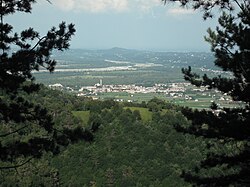Ciano (Crocetta del Montello)
| Crocetta del Montello | |
|---|---|
| Comune | |
| Comune di Crocetta del Montello | |
 |
|
| Location of Crocetta del Montello in Italy | |
| Coordinates: 45°50′N 12°2′E / 45.833°N 12.033°ECoordinates: 45°50′N 12°2′E / 45.833°N 12.033°E | |
| Country | Italy |
| Region | Veneto |
| Province / Metropolitan city | Province of Treviso (TV) |
| Frazioni | Crocetta-Nogarè, Borgo del Cristo, Borgo Santa Margherita, Ciano, Ponte di Pietra, Rivette, Santa Mama |
| Area | |
| • Total | 26.4 km2 (10.2 sq mi) |
| Elevation | 148 m (486 ft) |
| Population (Dec. 2004) | |
| • Total | 5,807 |
| • Density | 220/km2 (570/sq mi) |
| Demonym(s) | Crocettans; Crocettani (Italian); Crosetani (Venetian) |
| Time zone | CET (UTC+1) |
| • Summer (DST) | CEST (UTC+2) |
| Postal code | 31035 |
| Dialing code | 0423 |
Crocetta del Montello (or Croseta del Montel in the local Venetian dialect), formerly Crocetta Trevigiana, is a comune (municipality) in the Province of Treviso in the Italian region Veneto, located about 50 kilometres (31 mi) northwest of Venice and about 25 kilometres (16 mi) northwest of Treviso. As of 31 December 2004, it had a population of 5,807 and an area of 26.4 square kilometres (10.2 sq mi).
The town lies about 3 kilometres (2 mi) southwest of the Piave River, and borders the municipalities of Cornuda, Montebelluna, Moriago della Battaglia, Pederobba, Vidor, and Volpago del Montello. The present name literally means "Little Cross of the Little Hill", and refers to the Montello, an isolated hillock, 5 by 13 kilometres (3 by 8 mi) in size and 371 metres (1,217 ft) in elevation, that rises from the Piave's alluvial plain at the west edge of the town.
Traces of human occupation dating from the Mesolithic have been found along the north-east edge of the Montello, above the boroughs of Ciano and Santa Margehrita, which at the time were on the Piave river. The main finds are chipped stone tools that appear to be fishing spear points.
Ciano takes its name from an ancient Roman temple devoted to the cult of Cyane. The temple's focus was the Buoro di Ciano spring, which presently lies at the end of a 10-metre (33 ft) long grotto, and whose water was reputed to be beneficial to the health.
...
Wikipedia

